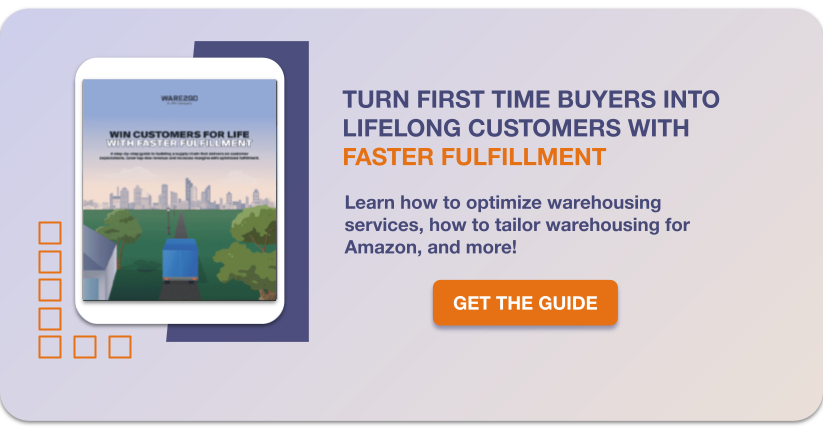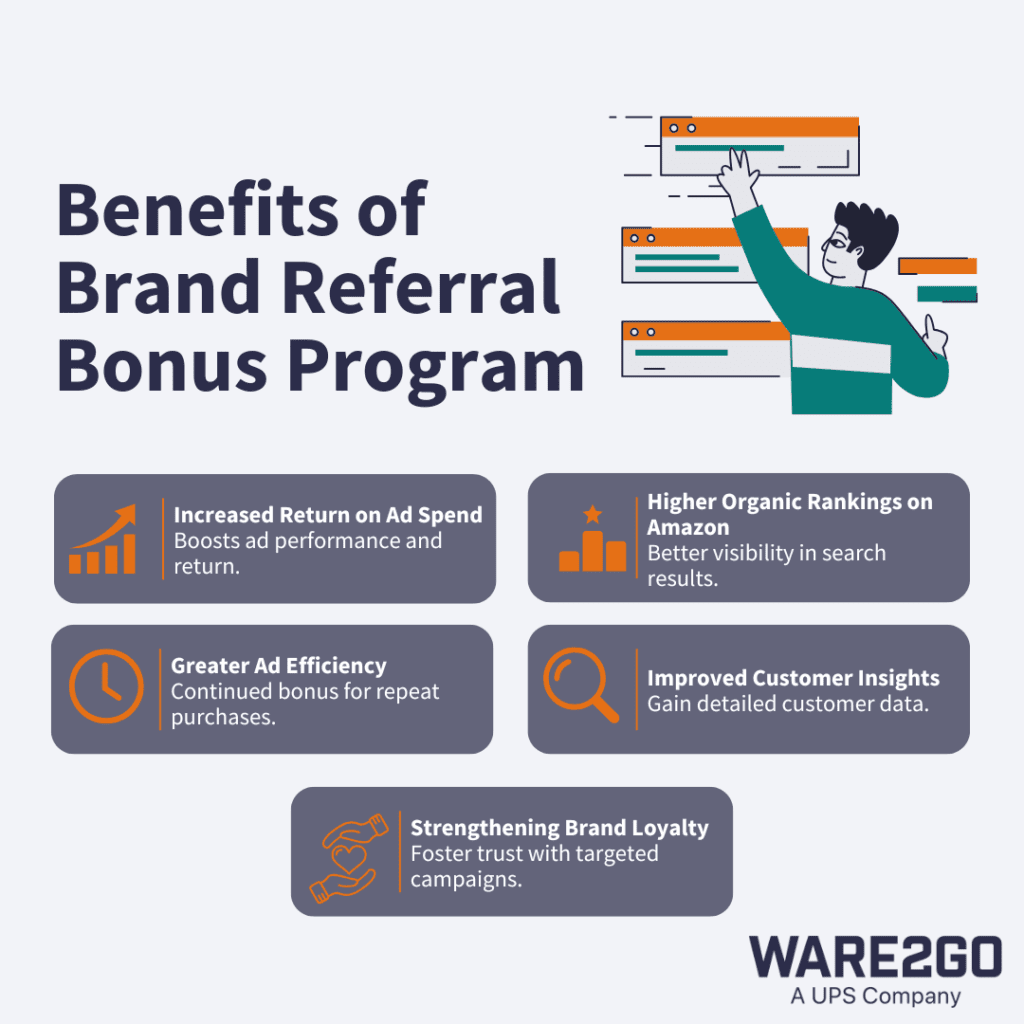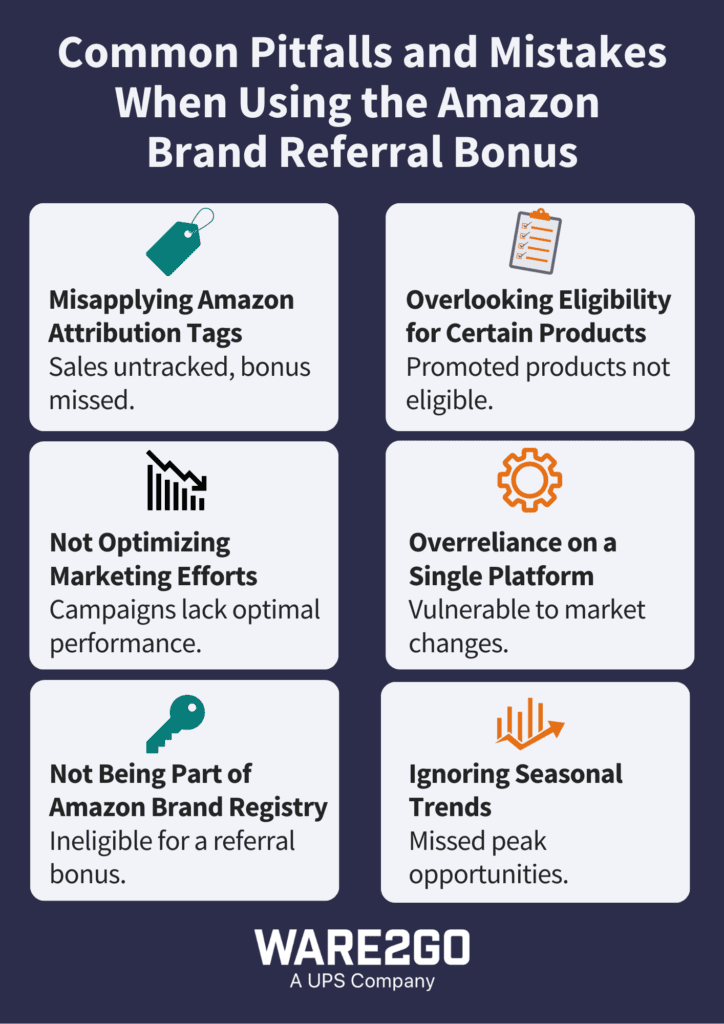The Amazon Brand Referral Bonus program is one strategic tool for sellers aiming to optimize their reach and revenue. Introduced to reward brand-registered sellers for driving external traffic to their Amazon listings, this program reduces referral fees by offering a 10% bonus on qualifying sales. As a result, Amazon has become a more appealing channel for omnichannel sellers.

To further streamline your fulfillment process and support your multichannel strategy, download our Amazon fulfillment ebook to provide scalable solutions tailored to your business needs.
This guide provides a comprehensive breakdown of the Amazon Brand Referral Bonus program, detailing its benefits, effective strategies, and common pitfalls to help you maximize your earnings through this opportunity.
What is the Amazon Brand Referral Bonus?
On July 15th, Amazon notified sellers of its new Brand Referral Bonus Program as an incentive and reward for driving off-Amazon traffic to their Amazon listings. Brand Registered Sellers enrolled in the program will receive a bonus of 10% on every sale made from an off-platform referral source.
The 10% bonus will come in the form of a credit on the seller’s referral fee — the cost associated with each sale made by third-party sellers on Amazon. Referral fees are charged as a percentage of the sale price, and depending on the product can range between 8% and 15%. What’s more, Amazon is recognizing the long-term value of customers driven to Amazon listings from referral traffic and is offering to continue to pay bonuses for purchases made by the same customer for up to 14 days after they’ve clicked on the ad.
In short, every time a shopper clicks an ad off-Amazon (whether on social media, paid Google ads, or a newsletter link), and that ad directs them to Amazon where they ultimately make a purchase, the Amazon Brand Referral Bonus pays that seller back 10% of their referral fee.
Why You Should Join the Amazon Brand Referral Bonus Program

Selling on Amazon has practically become a necessity for multichannel and omnichannel sellers. Amazon has now become the number one product search platform, with 74% of US shoppers indicating that their product searches begin on Amazon. However, Amazon is often one of the lowest-margin sales channels for many sellers. The high referral fees (compared to other marketplaces like Walmart and selling on their own ecommerce site) may limit the amount of paid advertising a seller can afford to invest in.
The Amazon Brand Referral Program essentially reduces the cost of selling on Amazon for third-party sellers, often to as low as 5% (before accounting for the cost of advertising).
This makes selling on Amazon much more attractive to most omnichannel sellers. Other benefits include:
Increased Return on Ad Spend
Especially for small brands, consumers often trust sales on Amazon more than non-affiliated ecommerce sites. There is a greater likelihood of converting a sale on an ad that directs a shopper to an Amazon listing than an ecommerce site.
Higher Organic Rankings on Amazon
Since the release of its latest algorithm, Amazon has been rewarding sellers who direct off-Amazon traffic to their listings with higher search rankings and helping sellers track their off-Amazon sales through Amazon Attribution.
Greater Ad Efficiency
The Brand Referral Bonus continues to reimburse sellers on their referral fees for off-Amazon traffic for any additional purchases made up to 14 days after the shopper initially clicks on the ad.
Improved Customer Insights
The Amazon Brand Referral Bonus program, combined with Amazon Attribution, provides valuable data on customer behaviors and preferences. These insights allow sellers to track the effectiveness of external marketing campaigns, better understand their audience, and refine targeting tactics. By leveraging this data, businesses can tailor product offerings and campaigns to meet customer needs more effectively, driving growth.
Strengthening Brand Loyalty
With the Brand Referral Bonus, sellers can reinvest in targeted marketing efforts that foster customer loyalty. Consistently driving external traffic through trusted campaigns helps establish stronger connections with customers, encouraging repeat purchases. This steady engagement not only builds trust but also reinforces the long-term relationship between the brand and its audience.
Potential Risks
Multichannel sellers do, however, need to consider the potential damage that directing all of their off-Amazon advertising efforts to Amazon listings could do for the longevity of their brand. The bonus program may be a great way to reduce the cost of selling on Amazon, but could eventually cost sellers brand recognition and growth of their ecommerce store if left unchecked. Emerging brands should weigh the benefits with the costs to find the right balance for their business.
A major factor to consider when deciding how much external traffic to divert to Amazon is the referral fee and anticipated bonus rate specific to the product category. Categories like Amazon Device Accessories can return up to a 30% bonus, while categories like Automotive and Power Sports only return a 7%-8% bonus. For sellers with a diverse product catalogue, it may make sense to segment your off-Amazon advertising efforts based on the expected rate of the referral bonus.
How Does the Brand Referral Bonus Work?
Amazon’s Brand Referral Bonus is available only to Brand Registered Sellers, and participating sellers must enroll in the program. Once enrolled, sellers will track their sales from off-platform advertising through Amazon Attribution.
Sellers will create an attribution tag, which like a pixel on Google or Facebook will follow the shopper on their purchase journey from their first click to their final purchase. Sellers will attach this attribution tag to their external marketing campaign, whether that’s paid advertising, a link in a newsletter, or a social media post. For each sale that’s made from external traffic, sellers will receive a credit on their referral fees equal to 10% of the purchase price.
How Will the Brand Referral Bonus Affect My Business?
With Amazon referral fees currently costing 15% per sale, this credit reduces the referral fee for sales made from off-Amazon traffic to only 5%. This makes the aspect of selling on Amazon much more attractive to multichannel sellers and may cause them to reprioritize their ecommerce ecosystem.
Additionally, with Amazon’s PPC advertising costs up 50% year over year, it makes sense to increase ad spend on external channels. Sellers get the bonus of higher organic search rankings and now a substantial kickback to offset their operating costs overall.
Amazon also leads the way in ecommerce strategies for other major players. Walmart’s search algorithms function very much like Amazon’s, and Walmart has already introduced an affiliate program much like Amazon’s to drive off-platform traffic. It’s likely that Amazon will soon follow suit with a similar strategy to incentivize more external marketing efforts from its third-party sellers.
Why Is Amazon Incentivizing Off-Amazon Advertising?
Early on, Amazon experts noticed that Amazon’s algorithm seemed to reward listings that drove higher volumes of off-Amazon traffic. Driving traffic from external sources like Google paid search and Facebook ads seemed to improve organic search rankings on Amazon. Then in 2018, Amazon launched Amazon Attribution, a tool for Brand Registered Sellers to monitor the performance of their off-Amazon advertising efforts.
Prior to Attribution, Sellers could see which sales resulted from their Amazon PPC campaigns, but the source of all other sales remained a mystery. By providing a tool for sellers to measure and optimize their off-Amazon campaigns, Amazon was sending a clear message to sellers that off-platform traffic was important and needed to be prioritized.
This message was confirmed with the A10 algorithm update. This iteration of the Amazon search algorithm placed much more value on off-Amazon traffic for search results. Amazon was clearly telling sellers that if they wanted to succeed on the platform, they needed to be directing customers from all over the web to Amazon.
So why is off-platform traffic so important to the current number one ecommerce platform that many have called an ecommerce search engine itself? While an estimated 50% or more of online shoppers begin their product search on Amazon, that leaves another 40% of shoppers that are starting their search on Google or another search engine, with the balance going directly to the merchant’s site or another marketplace. To continue growing its share of the ecommerce market, Amazon needs to own search and paid advertising across all channels.
With Walmart Marketplace establishing itself as a new ecommerce leader and destination for third party sellers, Amazon knows that to retain their number one position, an Amazon listing has to be at the top of every search ranking and highlighted in every sponsored post on shoppers’ social media timelines. The best way to do that is to incentivize their nearly 2 million third party sellers to canvas the internet on their behalf.
Using Amazon in Your Multichannel Strategy
This incentive will certainly lead some sellers to place higher priority on marketing their Amazon channel, but multichannel merchants should continue to grow all of their channels simultaneously.
In fact, Amazon can be leveraged to create brand awareness and acquire new customers as part of a multichannel strategy, but to do this, sellers must create a unique brand experience on Amazon and maintain as much control over customer interactions as possible.
One of the most effective tools for creating a unique brand experience on Amazon is through fulfillment. Amazon sellers who fulfill orders through Fulfillment by Merchant (FBM) or Seller Fulfilled Prime (SFP) have access to valuable customer data that can be used for re-marketing, getting customers to leave reviews, and establishing trust with their brand. Below are a few ways that choosing to manage your Amazon fulfillment internally or with an outsourced fulfillment partner can help you leverage Amazon to grow across all sales channels:
Custom Packaging
Custom packaging allows you to connect with your customers and establish your brand as soon as your package arrives on their doorstep. You can also ensure that your products are packaged efficiently to reduce shipping costs and damages, as well as offer eco-friendly packaging options, which 64% of consumers indicate is important to their decision whether or not to make a purchase online.
Customer Data
FBA does not allow third-party sellers to access customer data that can be used for targeted marketing, mailing lists, and building rapport and Lifetime Value with customers. Choosing a fulfillment partner outside of Amazon’s fulfillment network allows you to use Amazon as a lever to grow your brand across all sales channels.
Streamlined Experience Across Channels
Finding a fulfillment partner that can satisfy the fulfillment requirements of all your sales channels will help you create a cohesive, repeatable experience for your customers no matter where they make their purchase. Managing fulfillment across all channels through a single partner will also simplify your internal process and free up bandwidth to focus on sales, marketing, and product development.
Looking for an Amazon fulfillment solution? Schedule a time to talk to one of our in-house experts.
Tips to Maximize Your Amazon Referral Bonus

1. Use Amazon Attribution Effectively
Correctly setting up Amazon Attribution tags is critical for tracking and crediting all external traffic to your listings. Accurate tagging enables you to better measure campaign performance, identify high-performing channels, and boost ROI from your external traffic sources.
2. Optimize Your Product Listings
Ensure your product pages are primed for conversions with high-quality images, compelling copy, and strategically chosen keywords. An optimized listing helps convert the traffic you drive, turning clicks into purchases. Strong product pages are the foundation for capitalizing on external traffic campaigns.
3. Diversify External Traffic Channels
Expand your reach by utilizing multiple marketing channels, such as social media, email campaigns, and influencer partnerships. Diversifying traffic sources amplifies visibility, driving more sales and increasing your referral bonus potential. With 50% of marketers meeting their financial goals through varied channels, this approach is a proven method for success.
4. Run Data-Driven Campaigns
Leverage tools like Amazon Attribution and Google Analytics to track and analyze the performance of external traffic. Use these insights to refine your campaigns, focusing on what drives results. Data-driven adjustments not only optimize your bonus eligibility but also improve the overall ROI of your marketing efforts.
5. Leverage Seasonal Trends
Align your campaigns with key sales periods, such as holiday promotions or seasonal peaks, to maximize your referral bonus. Timing your efforts with high-spending periods, like the 2024 holiday season when Amazon was projected to generate $112.23 billion in sales, ensures your marketing efforts yield the greatest return.
6. Stay Updated with Program Changes
Regularly review Amazon’s updates to the Brand Referral Bonus program to adapt your strategies as needed. Staying informed about policy changes ensures compliance and helps you maintain eligibility for the bonus, safeguarding your long-term success in the program.
6 Common Pitfalls and Mistakes When Using the Amazon Brand Referral Bonus

It’s important to stay ahead of potential hiccups that can result in less ROI on your Brand Referral Bonus efforts. Below are 6 common pitfalls that many third-party sellers fall into.
1. Misapplying Amazon Attribution Tags
Failing to use Amazon Attribution tags correctly can result in untracked sales, meaning you won’t receive the Brand Referral Bonus you’ve earned. Misapplied or missing tags also prevent you from gaining valuable insights into campaign performance. Accurate tagging is essential to ensure your efforts are attributed correctly, maximizing your ROI and bonus eligibility.
2. Overlooking Eligibility for Certain Products
Promoting ineligible products is a common mistake that wastes valuable marketing resources. Amazon’s Brand Referral Bonus program only applies to certain products, so failing to align your campaigns with this list can lead to missed opportunities. Regularly review the list of qualifying products to ensure your marketing focuses on items that maximize your returns.
3. Not Optimizing Marketing Efforts
Launching campaigns without sufficient optimization can limit their effectiveness and reduce your bonus potential. Regularly analyze performance metrics, such as click-through and conversion rates, to refine your strategies. Leveraging data-driven insights allows you to continuously improve your campaigns, ensuring maximum ROI and bonus earnings.
4. Overreliance on a Single Platform
Relying exclusively on Amazon for traffic and sales leaves your business vulnerable to market shifts or policy changes. Diversifying your external traffic sources—such as social media, email marketing, or other marketplaces—creates a more resilient business model. This approach ensures sustainable growth and protects your brand from potential disruptions.
5. Not Being Part of Amazon Brand Registry
Enrollment in Amazon’s Brand Registry is a prerequisite for participating in the Brand Referral Bonus program. Beyond this requirement, the registry offers benefits like access to A+ Content, brand analytics, and enhanced brand protection. These tools not only improve marketing effectiveness but also boost your brand’s credibility, making registration an essential step for success.
6. Ignoring Seasonal Trends
Overlooking the timing of your campaigns is a missed opportunity to maximize your referral bonus. Aligning your efforts with peak shopping seasons or holidays, when consumer spending is at its highest, can significantly boost your returns. Plan your campaigns strategically to capitalize on these high-traffic periods.
The Future of Multichannel Retail
Amazon accounts for 37% of online sales and can’t be ignored as a sales channel for most merchants, but social media platforms continue to build out new shopping capabilities, and shopping carts like Shopify and BigCommerce continue to evolve in order to compete with Amazon. This means that ecommerce will continue to become more and more ubiquitous, and merchants looking to compete will need to build out more than just their Amazon strategy in order to compete.
Looking for a multichannel fulfillment solution? Talk to one of our ecommerce fulfillment experts.
FAQ about Amazon Brand Referral Bonus
What types of referrals qualify for the bonus?
Referrals that qualify for the Amazon Brand Referral Bonus must originate from external traffic sources, such as social media, email campaigns, paid ads, or influencer promotions. The sales must be tracked using Amazon Attribution tags, and the promoted products must be part of Amazon’s eligible product list.
Are there fees to participate?
No, there are no additional fees to participate in the Amazon Brand Referral Bonus program. Sellers simply need to enroll in the Amazon Brand Registry, set up Amazon Attribution, and run external marketing campaigns to qualify for the bonus.
How can sellers track their referral earnings?
Sellers can track their referral earnings through the Amazon Attribution dashboard. The platform provides detailed insights into the performance of external campaigns, including attributed sales and bonus earnings. Regularly reviewing these metrics helps sellers optimize their campaigns for better results.
How long does it take to receive bonuses?
Referral bonuses are typically paid out within two months after the qualifying sale. The bonus is credited to the seller’s Amazon account, and the timeline may vary slightly depending on Amazon’s payment schedule and any applicable processing times.
Maximize Your Amazon Referral Bonus with Ware2Go
The Amazon referral bonus is more than just a cost-saving tool; it enables sellers to drive external traffic while maintaining cost efficiency and competitive positioning. Using this bonus as part of your ecommerce strategy enhances cross-channel performance and fuels growth.
Sellers who embrace the Amazon referral bonus gain actionable insights, improve campaign outcomes, and position their brand for long-term success. With Ware2Go’s tailored, tech-driven solutions, you can focus on growing your business while we handle the logistics. Contact us today to learn how we can help you maximize the benefits of the Amazon Brand Referral Bonus program.



